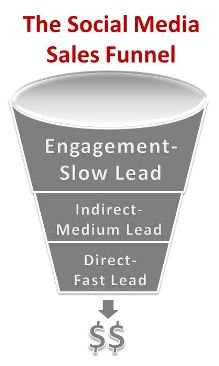 Are you finding your social media efforts aren't generating enough leads? Do the ones that come through “die on the vine”? This article will tell you why and what to do about it.
Are you finding your social media efforts aren't generating enough leads? Do the ones that come through “die on the vine”? This article will tell you why and what to do about it.
To fix the lead problem, you need to be able to easily identify where your “system” is breaking. There's only one place to look for holes in your lead generation efforts: your sales funnel.
I faced this exact challenge and found that it wasn't my strategies that weren't delivering—it was the sales process that social media leads were being put through. Once I identified that, I worked on building a better sales process for social media leads.

Here are 4 tips to help you convert your leads.
#1: Identify Traditional Online Leads
Consider the type of leads you have coming in from traditional channels and where they're coming from. Some traditional online channels that are putting leads through your sales cycle probably include paid search, affiliate advertising, banner advertising and I'm sure there are others.
However, what is similar in all of these? They deliver leads with a call to action that's for immediate gratification and results in a very “short” sales cycle. They drive the lead to a landing page to “convert now.”
#2: Identify Social Media Leads
Consider the type of leads that are coming from social media outlets. Some fairly common social media channels that are putting leads through your sales cycle probably include Twitter, Facebook, YouTube, LinkedIn, blogs and the list goes on.
What's different? Think about where you're driving these leads. They're engaging with content, not landing pages. At the point where they get to a landing page, it's probably the same landing page that you sent your other leads to.
#3: Differentiating Between Traditional and Social Leads
You can break leads up into three groups: those who responded to direct conversion points, those who responded to indirect conversion points and those who responded to engagement conversion points.

- Direct Conversion Points: People have responded to an ad to buy your product or service. They've shown a clear indication that they're interested in your product or service and are going to buy within a short time. They've responded by clicking on a paid search, affiliate or banner advertisement or have responded to an advertisement for an “offer” that they want.
- Indirect Conversion Points: People have downloaded one of your ebooks, attended a non-product–based webinar or subscribed to your newsletter or blog.
Essentially, these people have provided their contact information in response to a “piece of content” that they want.

Discover Proven Marketing Strategies and Tips
Want to go even deeper with your marketing? Check out the Social Media Marketing Podcast! Publishing weekly since 2012, the Social Media Marketing Podcast helps you navigate the constantly changing marketing jungle, with expert interviews from marketing pros.
But don’t let the name fool you. This show is about a lot more than just social media marketing. With over 600 episodes and millions of downloads each year, this show has been a trusted source for marketers for well over a decade.
- Engagement Conversion Points:
Those who have clicked on your tweets, followed you, become a fan on Facebook, liked your status update or even commented. They've interacted with you, but you don't have their contact information because they haven't filled out one of your lead forms yet.
Each conversion point is different and should be treated differently. If you think in terms of a sales funnel, these points would stack on top of each other. They could be used to represent an estimated time frame to the point of close or sales conversion.
The time frame will depend on the length of your standard sales cycle. For example, if your sales cycle was 1 to 30 days for your longest direct conversion point lead, you might find that social media leads represent 31 to 60 days for the indirect lead and 61 to 90 days for the engagement lead.
#4: Identify Where You're Losing Social Media Leads

If you're treating the social media lead the same way you're treating the direct conversion point lead, you're likely killing the sales before they have time to mature.
Get World-Class Marketing Training — All Year Long!
Are you facing doubt, uncertainty, or overwhelm? The Social Media Marketing Society can help.
Each month, you’ll receive training from trusted marketing experts, covering everything from AI to organic social marketing. When you join, you’ll also get immediate access to:
- A library of 100+ marketing trainings
- A community of like-minded marketers
- Monthly online community meetups
- Relevant news and trends updates
The first step to converting social media leads is to understand where they fit in the sales funnel as we've discussed here.
The next step is to know what to do differently so you can facilitate their movement through the sales funnel to the sale.
You may find that you don't have a sales and marketing process that supports this type of lead and if that's the case, there will be some work to do before your social media sales results will improve.

Immediate Action Item
Follow a few of your social media leads to see their path, document what communications they receive and when they convert or when they fall off. You can identify fall-off because they'll unsubscribe to your emails or stop opening them, or they could even unfollow or un-‘like' you. If you spot-check ten or so leads who have responded to an indirect conversion point, you'll immediately identify a pattern of where your sales process is killing your sale to give you the data you need for a more in-depth analysis.
To learn more, check out 5 Social Media Mistakes That Hurt Sales, the 3 Ways to Close the Gap Between Social Media and Direct Response and the 3 Ways Twitter Analysis Can Enhance Your Marketing.
How do you track your social media leads? Are they working? Leave your questions and comments in the box below.
All photos from Shutterstock.
Attention Agency Owners, Brand Marketers, and Consultants

Introducing the Marketing Agency Show–our newest podcast designed to explore the struggles of agency marketers.
Join show host and agency owner, Brooke Sellas, as she interviews agency marketers and digs deep into their biggest challenges. Explore topics like navigating rough economic times, leveraging AI, service diversification, client acquisition, and much more.
Just pull up your favorite podcast app, search for Marketing Agency Show and start listening. Or click the button below for more information.

